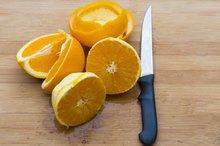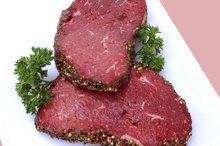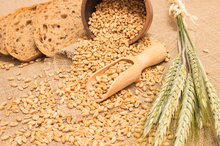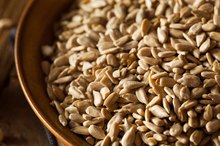What does fact checked mean?
At Healthfully, we strive to deliver objective content that is accurate and up-to-date. Our team periodically reviews articles in order to ensure content quality. The sources cited below consist of evidence from peer-reviewed journals, prominent medical organizations, academic associations, and government data.
- National Institutes of Health Clinical Center: Important Information to Know When You Are Taking: Warfarin (Coumadin) and Vitamin K
- Office of Dietary Supplements: Iron
The information contained on this site is for informational purposes only, and should not be used as a substitute for the advice of a professional health care provider. Please check with the appropriate physician regarding health questions and concerns. Although we strive to deliver accurate and up-to-date information, no guarantee to that effect is made.
Foods High in Iron That Will Not Interfere With Coumadin
When taking the blood thinner Coumadin, also called warfarin, you need to eat a consistent amount of vitamin K each day. Coumadin slows down the blood-clotting actions of vitamin K, so the appropriate dosage depends on how much vitamin K you consume. Vitamin K is found in significant amounts in green leafy vegetables, avocado, asparagus, peas, prunes and tuna canned in oil, so you need to watch your intake of these foods. This still leaves a lot of iron-rich foods for you to choose from.
Iron-Rich Foods
Foods high in iron have at least 3.6 milligrams of iron, or 20 percent of the daily value. Breakfast cereals are often fortified with 100 percent of the daily value for iron, but rarely contain significant amounts of vitamin K. Some types of seafood are also low in vitamin K and high in iron, such as:
- clams
- cuttlefish
- octopus
- oysters
Other animal-based sources of iron include turkey breast and lean beef plate steak. Although some beans are a bit higher in vitamin K, lentils and navy beans don't contain a lot of this nutrient but contain significant amounts of iron 1.
Related Articles
References
- USDA National Nutrient Database: Nutrient Lists: Iron and Vitamin K
- Office of Dietary Supplements: Iron
- U.S. Department of Health and Human Services. National Institutes of Health. Iron Fact Sheet for Health Professionals. Office of Dietary Supplements. Published 2019.
- Sun J, Zhang L, Cui J et al. Effect of dietary intervention treatment on children with iron deficiency anemia in China: a meta-analysis. Lipids Health Dis. 2018;17(1). doi:10.1186/s12944-018-0749-x
- Beck KL, Conlon CA, Kruger R, Coad J. Dietary determinants of and possible solutions to iron deficiency for young women living in industrialized countries: a review. Nutrients. 2014;6(9):3747-76. doi:10.3390/nu6093747
- Hurrell R, Egli I. Iron bioavailability and dietary reference values. Am J Clin Nutr. 2010;91(5):1461S-1467S. doi:10.3945/ajcn.2010.28674F
- Institute of Medicine. 2001. Dietary Reference Intakes for Vitamin A, Vitamin K, Arsenic, Boron, Chromium, Copper, Iodine, Iron, Manganese, Molybdenum, Nickel, Silicon, Vanadium, and Zinc. Washington, DC: The National Academies Press. doi:10.17226/10026
- Zijp IM, Korver O, Tijburg LB. Effect of tea and other dietary factors on iron absorption. Crit Rev Food Sci Nutr. 2000;40(5):371-98. doi:10.1080/10408690091189194
- Centers for Disease Control and Prevention. Iron.
- Makrides, M., Hawkes, J. S., Neumann, M. A., & Gibson, R. A. (2002). Nutritional effect of including egg yolk in the weaning diet of breast-fed and formula-fed infants: a randomized controlled trial. The American Journal of Clinical Nutrition, 75(6), 1084–1092. doi:10.1093/ajcn/75.6.1084
- Itske M. Zijp, Onno Korver & Lilian B. M. Tijburg (2000) Effect of Tea and Other Dietary Factors on Iron Absorption, Critical Reviews in Food Science and Nutrition,40:5, 371-398, doi:10.1080/10408690091189194
- Lönnerdal, B. (2010). Calcium and Iron Absorption - Mechanisms and Public Health Relevance. International Journal for Vitamin and Nutrition Research, 80(45), 293–299. doi:10.1024/0300-9831/a000036
- Geerligs PD, Brabin BJ, Omari AA. Food prepared in iron cooking pots as an intervention for reducing iron deficiency anaemia in developing countries: a systematic review. J Hum Nutr Diet. 2003;16(4):275-81. doi:10.1046/j.1365-277X.2003.00447.x
- Abhilash KP, Arul JJ, Bala D. Fatal overdose of iron tablets in adults. Indian J Crit Care Med. 2013;17(5):311-3. doi:10.4103/0972-5229.120326
- Hamilton JPA, By, Hamilton JPA. Secondary Iron Overload - Blood Disorders. Merck Manuals Consumer Version.
- Iron - Infant and Toddler Nutrition. Centers for Disease Control and Prevention. Published 2018.
- Milk Free Diet For Iron Deficiency Anemia. Children's Hospitals and Clinics of Minnesota.
- Abhilash KP, Arul JJ, Bala D. Fatal overdose of iron tablets in adults. Indian J Crit Care Med. 2013;17(5):311–313. doi:10.4103/0972-5229.120326
- Beck KL, Conlon CA, Kruger R, Coad J. Dietary determinants of and possible solutions to iron deficiency for young women living in industrialized countries: a review. Nutrients. 2014;6(9):3747–3776. Published 2014 Sep 19. doi:10.3390/nu6093747
- de Benoist B, McLean E, Egil I, Cogswell M, eds. Worldwide Prevalence of Anaemia 1993-2005. World Health Organization, Centers for Disease Control and Prevention.
- Geerligs P, Brabin B, Omari A. Food prepared in iron cooking pots as an intervention for reducing iron deficiency anaemia in developing countries: a systematic review. Journal of Human Nutrition and Dietetics. 2003;16(4):275-281. doi:10.1046/j.1365-277x.2003.00447.x
- Hamilton, JPA. Secondary Iron Overload - Blood Disorders. Merck Manuals Consumer Version. February 2019.
- Hurrell R, Egli I. Iron bioavailability and dietary reference values. The American Journal of Clinical Nutrition. 2010;91(5). doi:10.3945/ajcn.2010.28674F
- Johnson-Wimbley T, Graham D. Diagnosis and management of iron deficiency anemia in the 21st century. Therap Adv Gastroenterol. 2011;4(3):177-184. doi:10.1177/1756283x11398736
- Verster A. Food fortification: good to have or need to have? Eastern Mediterranean Health Journal. 2004;10(6).
Writer Bio
Based in Massachusetts, Jessica Bruso has been writing since 2008. She holds a master of science degree in food policy and applied nutrition and a bachelor of arts degree in international relations, both from Tufts University.









